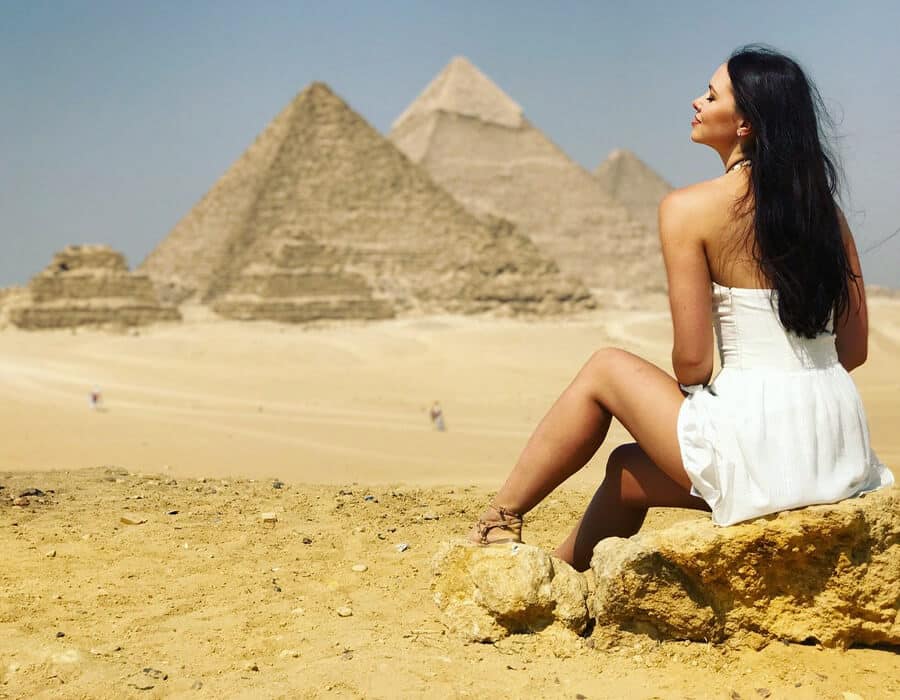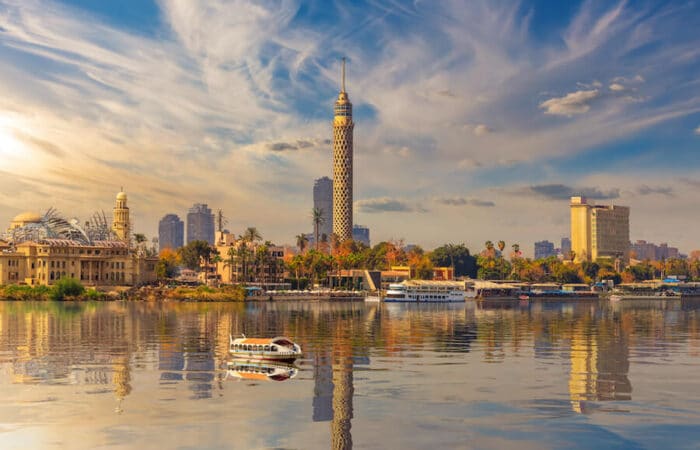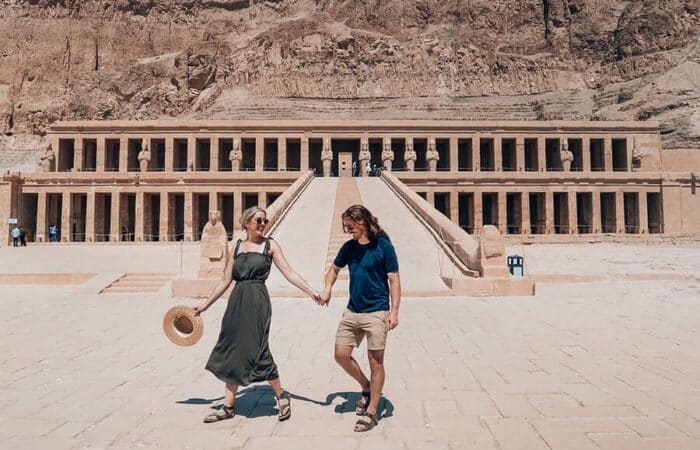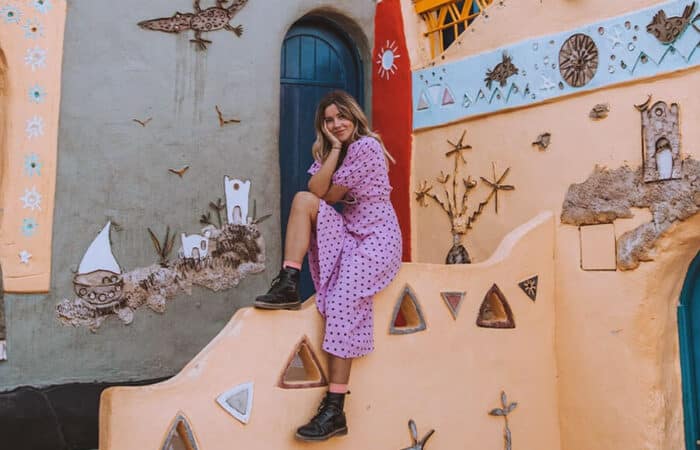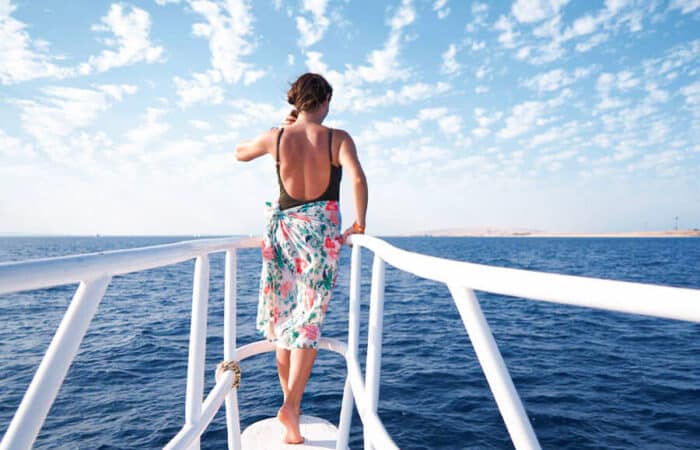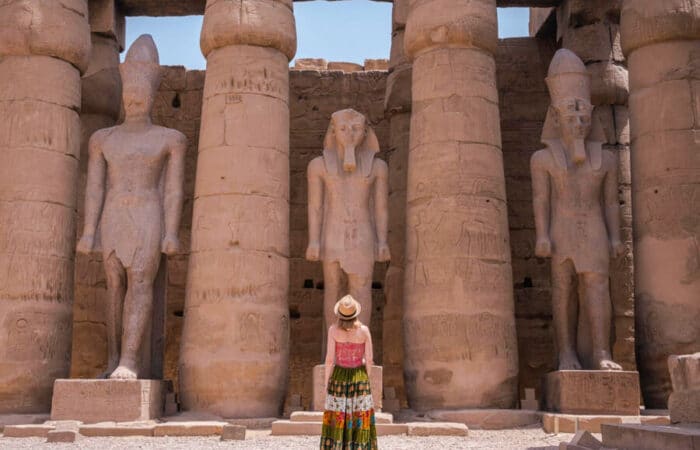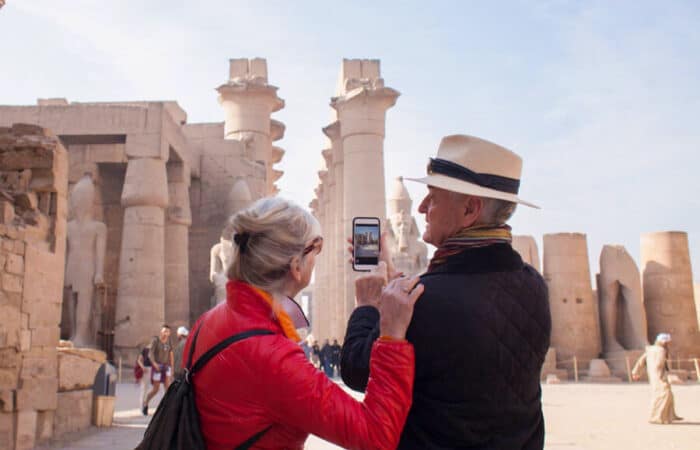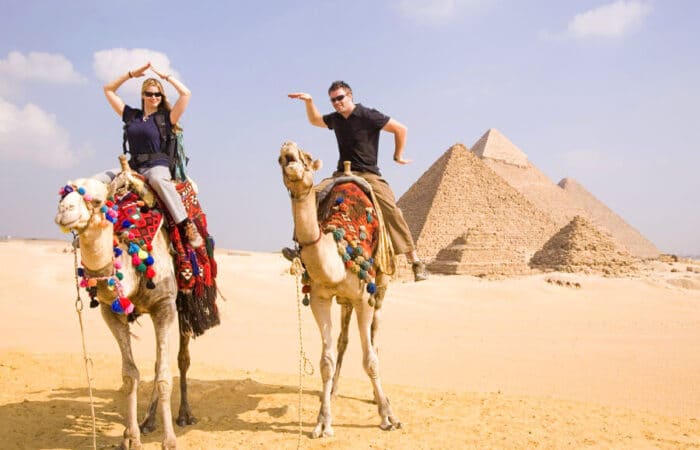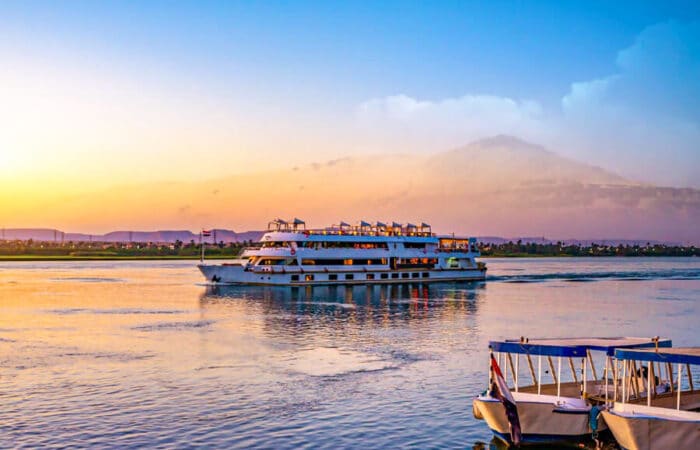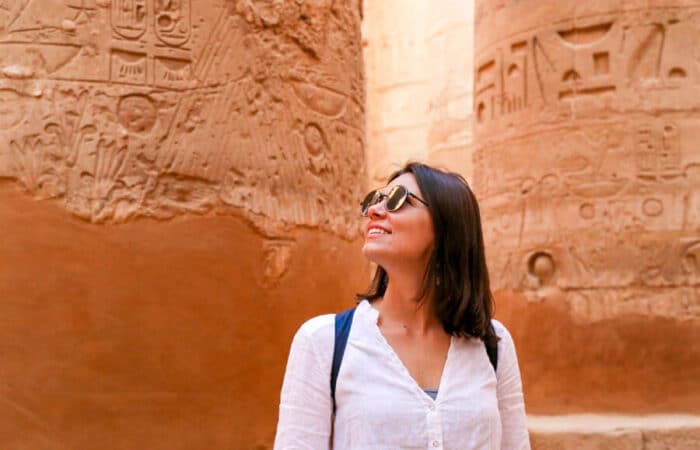Things to do in Giza aren’t just about pyramids — they’re a gateway into Egypt’s soul. Did you know Giza hosts secret tombs, ancient markets, and serene desert escapes beyond the iconic Sphinx? Whether you’re chasing bucket-list wonders or hidden gems, this guide reveals unforgettable experiences that will transform your trip into a once-in-a-lifetime adventure.
In this article, you will discover:
- The most famous and hidden places to visit in Giza.
- Unique cultural experiences beyond the Pyramids.
- Insider tips to avoid tourist traps and find authentic spots.
- Travel tips for getting around safely and affordably.
- Expert recommendations for unforgettable Giza adventures.
1- Top Attractions You Can’t Miss
The Great Pyramids of Giza
No visit to Giza is complete without standing in awe before the legendary Great Pyramids of Giza — the last surviving Wonder of the Ancient World. Built over 4,500 years ago, these colossal monuments were constructed as eternal resting places for Pharaohs and continue to captivate travelers with their mystery, engineering marvel, and historical importance.
The three main pyramids — Khufu (the Great Pyramid), Khafre, and Menkaure — each have unique features worth exploring:
- Khufu’s Pyramid: The largest and oldest, originally towering at 146 meters (now 138 meters), offering rare opportunities for visitors to enter the internal chambers (limited tickets daily).
- Khafre’s Pyramid: Recognizable by its still-intact capstone at the top, positioned near the iconic Sphinx.
- Menkaure’s Pyramid: Smaller yet distinguished by more intricate masonry work.
Travel Tip: Buy tickets in advance if you wish to enter the Great Pyramid — they sell out fast, especially during the peak season (October to April).
Insider Insight: Despite popular belief, the pyramids are surprisingly close to the modern city of Giza — offering surreal views where ancient wonders meet urban life.
Fun Fact: Each limestone block used in the pyramids weighs an average of 2.5 tons, with some weighing over 80 tons!
The Sphinx: Secrets and Legends
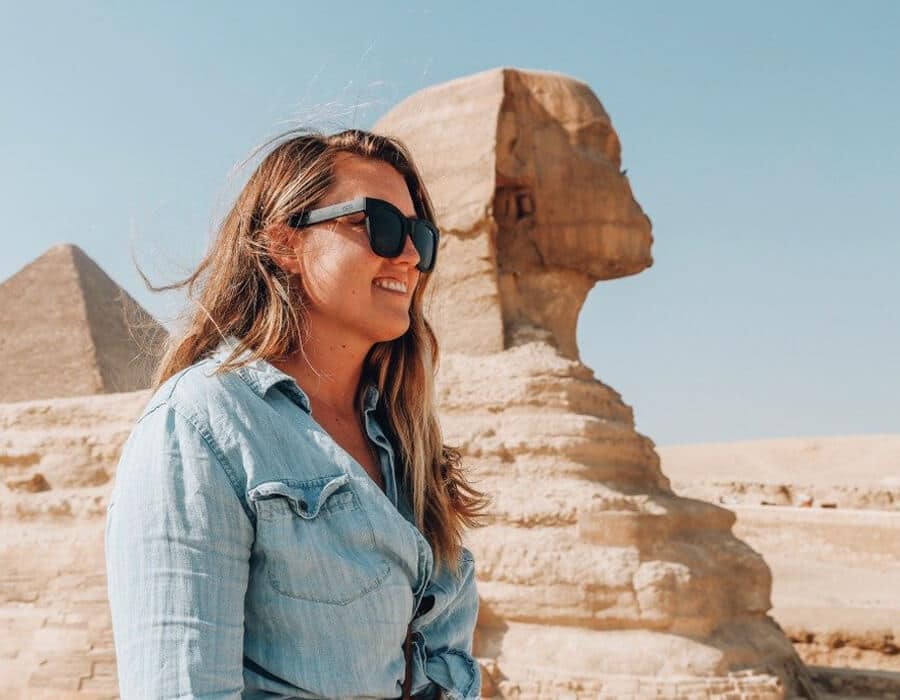
Lying majestically near the Great Pyramids, the Great Sphinx of Giza is one of the world’s oldest and most iconic monuments. Carved from a single limestone ridge around 2500 BCE, this enigmatic statue — part lion, part human — represents Pharaoh Khafre and symbolizes strength, wisdom, and divine power.
Standing 20 meters high and 73 meters long, the Sphinx has stirred countless myths and mysteries over millennia:
- Missing Nose Mystery: Contrary to popular legend, the Sphinx’s nose was likely destroyed long before Napoleon’s troops arrived — some historians suggest it was deliberately removed during the 14th century.
- Hidden Chambers: Some researchers and archaeologists theorize there may be secret tunnels or chambers beneath the Sphinx, although no definitive evidence has yet been found.
- Symbolism: Scholars believe the Sphinx’s alignment with the rising sun ties it to ancient Egyptian sun worship and royal divinity.
Expert Tip: Visit early in the morning to capture incredible photos without large crowds, and to see the Sphinx dramatically lit by the soft desert light.
Did You Know? Restoration efforts have been ongoing since the 1920s to protect the Sphinx from erosion caused by wind, sand, and modern urban encroachment.
Unique Experiences in Giza
Camel Rides at Sunset
Few experiences capture the timeless magic of Egypt like a camel ride across the golden sands of Giza at sunset. As the sun dips below the horizon, the Pyramids cast long shadows over the desert, creating a surreal and unforgettable scene.
Why It’s Unmissable:
- Iconic Backdrop: Watch the Pyramids glow under vibrant shades of orange, pink, and purple — an unbeatable photo opportunity.
- Local Tradition: Riding camels has been part of Egyptian culture for thousands of years, offering a glimpse into ancient travel methods across the desert.
- Peaceful Atmosphere: Away from daytime crowds, the cooler evening air and serene landscape create a much more intimate and magical experience.
Pro Tip: Always book your camel ride through a licensed tour operator or through your hotel to avoid tourist scams. Make sure the camel handler sets a clear price before you start.
Safety Tips:
- Wear comfortable, breathable clothing and closed-toe shoes.
- Hold onto the saddle firmly, especially when the camel rises and kneels (it can be a sudden jolt!).
- Bring a lightweight scarf or sunglasses to shield yourself from dust.
Fun Fact: In ancient times, camels were known as the “ships of the desert” for their ability to travel long distances without water — making them essential companions for traders and explorers.
Traditional Egyptian Dinner Experiences
Exploring Giza isn’t just about ancient monuments — it’s also about immersing yourself in the flavors of authentic Egyptian cuisine. A traditional dinner experience offers more than just food; it’s a cultural journey that reveals Egypt’s rich heritage through spices, storytelling, and warm hospitality.
What to Expect from a Local Dinner Experience:
- Home-Hosted Meals: Many travelers opt for home-cooked dinners hosted by local families. These intimate settings give you a taste of real Egyptian life and dishes passed down through generations.
- Cultural Entertainment: Some dinner venues offer live music, belly dancing, or traditional folk performances — a lively way to cap off a day of sightseeing.
- Authentic Flavors: Staples include koshari (lentils, pasta, and fried onions), molokhia (a garlicky green soup), grilled kofta, and freshly baked baladi bread.
Recommended Spots:
- Felfela Giza: Known for its cozy atmosphere and classic Egyptian comfort food.
- Nile-side dinner cruises: Combine dining with breathtaking views of Cairo’s skyline.
- Khan El Khalili-inspired restaurants: Offer ambiance that reflects old Cairo’s souk culture.
Pro Tip: Look for restaurants frequented by locals rather than tourist-heavy chains. The best meals often come from modest-looking places with strong reputations.
Desert Stargazing Tours
When the sun sets and the crowds fade, the Giza Plateau transforms into a tranquil gateway to the cosmos. Far from the city lights, desert stargazing tours offer a rare and magical chance to witness the night sky much like ancient Egyptians did — under a canopy of stars that once guided their calendars and beliefs.
Why Stargazing in Giza Is Unforgettable:
- Minimal Light Pollution: Just outside the bustling city, the desert skies become incredibly clear — ideal for viewing constellations, planets, and the Milky Way.
- Astronomy + Mythology: Many tours include guided sessions where astronomers or local storytellers explain the links between ancient Egyptian mythology and celestial bodies.
- Once-in-a-Lifetime Atmosphere: Settle onto Bedouin carpets, sip mint tea, and gaze up in silence — the serenity and sense of history are powerful.
What’s Included in a Typical Tour:
- Transportation from your hotel or a central meeting point
- Traditional dinner or tea service in the desert
- Telescopic viewing and star mapping with an expert guide
- Optional extras: camel rides, fire shows, or musical performances
Pro Tip: Bring a jacket — desert temperatures can drop sharply at night, even in summer. A camera with manual exposure settings will help you capture incredible star-filled skies.
Expert Insight: According to astrophysicist Dr. Nour El-Far, “The stars over Giza are remarkably visible. It’s one of the few places where you can feel the same awe the ancient Egyptians felt — linking astronomy with architecture and spirituality.”
Hidden Gems and Local Favorites
Explore Saqqara and the Step Pyramid
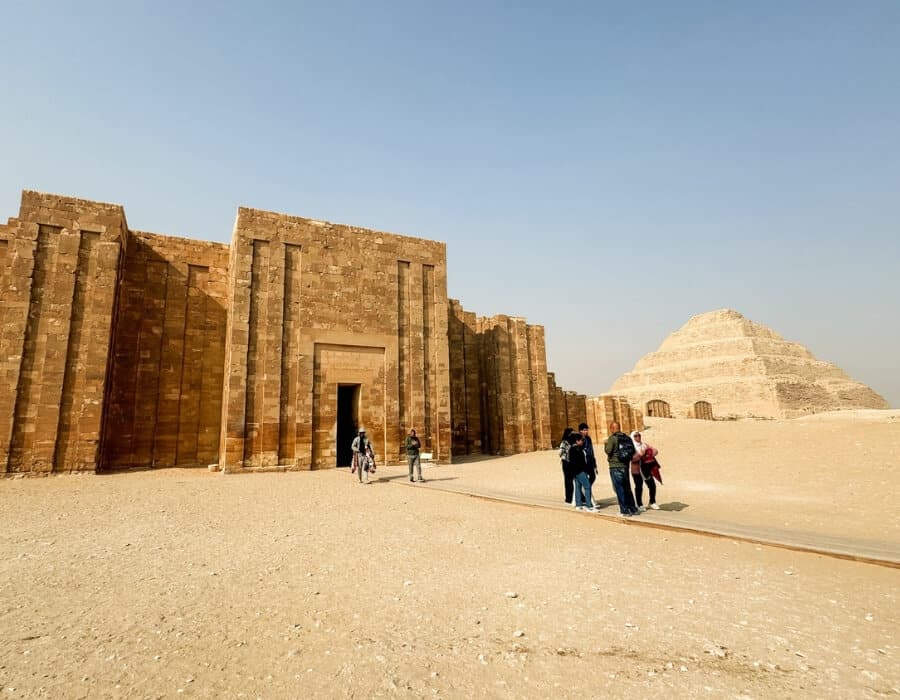
While Giza’s Great Pyramids steal the spotlight, Saqqara — just 30 kilometers south — is where Egypt’s pyramid-building legacy truly began. Home to the Step Pyramid of Djoser, Saqqara is one of the most important archaeological sites in the world, offering a deeper, quieter, and more immersive experience for history lovers.
Why Saqqara Is a Must-Visit:
- Oldest Pyramid in Egypt: Built during the 27th century BCE, the Step Pyramid was designed by Imhotep, the pharaoh’s architect, and is considered the first stone building complex in human history.
- Far Fewer Tourists: Compared to Giza, Saqqara is peaceful and less commercialized — perfect for travelers seeking depth and authenticity.
- Diverse Monuments: The site includes mastabas, tombs with vivid wall carvings, and the Serapeum, where sacred Apis bulls were buried in massive granite sarcophagi.
Key Highlights:
- Enter the Step Pyramid complex, recently restored and now open to visitors.
- Visit Tomb of Kagemni or Tomb of Ti, where hieroglyphs and daily-life carvings are remarkably well preserved.
- Explore the Heb-Sed Court, which re-creates royal rituals and festivals carved in stone.
Pro Tip: Hire a licensed Egyptologist guide here — their insights bring the subtle symbols and historical context to life, especially in lesser-known tombs.
Did You Know? Imhotep, the Step Pyramid’s architect, was so revered that he was later deified as the god of medicine and wisdom — a rare honor for a non-royal.
Visit the Grand Egyptian Museum (GEM)
Set to become the largest archaeological museum in the world, the Grand Egyptian Museum (GEM) is one of Giza’s most exciting modern attractions — merging ancient treasures with cutting-edge design. Located just 2 kilometers from the Giza Plateau, it’s a must-visit for anyone who wants to experience 5,000 years of Egyptian history in one stunning location.
Why You Should Visit GEM:
- Unprecedented Collection: Over 100,000 artifacts, including the entire King Tutankhamun collection, many items displayed for the first time ever.
- Modern Technology Meets Antiquity: Features interactive exhibits, augmented reality displays, and climate-controlled galleries.
- Architectural Wonder: The building itself is a spectacle — a vast, glass-fronted complex offering views of the pyramids from inside the museum.
Highlights to Look For:
- Tutankhamun’s funerary mask, jewelry, and chariots — housed together in a single exhibit for the first time.
- The massive Colossus of Ramses II, which greets visitors in the Grand Hall.
- Royal Mummies Gallery (pending final exhibit openings), offering a close look at Egypt’s most famous pharaohs.
Pro Tip: Check the museum’s official website before your visit — opening hours, exhibit access, and guided tour options can vary as the museum continues to expand its offerings throughout 2025.
Souk Shopping in Giza: Best Markets
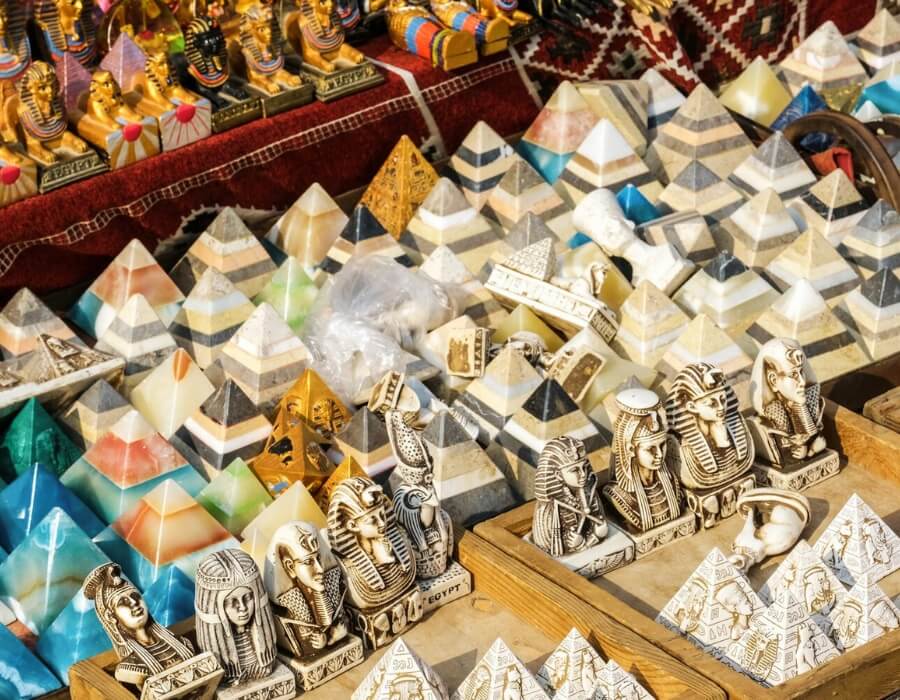
While Giza is famed for its ancient wonders, its vibrant local markets (souks) offer an equally unforgettable experience. From handmade crafts to aromatic spices, souk shopping in Giza is the perfect way to engage with modern Egyptian culture and support local artisans.
What You’ll Find in Giza’s Souks:
- Handcrafted Souvenirs: Papyrus art, alabaster statues, traditional jewelry, and mini pyramids carved from limestone.
- Spices & Perfumes: Discover bold flavors like cumin, hibiscus, and dukkah, along with fragrant oils such as lotus and myrrh.
- Textiles & Clothing: Colorful scarves, galabeyas (traditional robes), and embroidered accessories.
Best Markets to Explore:
- Khan el-Khalili (nearby in Cairo): While not technically in Giza, it’s easily reached and offers a centuries-old market experience. Great for antiques, silverwork, and café culture.
- El-Haram Street Bazaars: Smaller but more local-focused, these stalls near the Giza Plateau are ideal for quick souvenir finds.
- Mena House Artisan Shops: Located near the historic hotel, these curated shops offer higher-quality crafts and less haggling.
Shopping Tips:
- Haggling is expected — aim to counter-offer with 50–60% of the original price.
- Bring small Egyptian pounds (EGP) for better negotiation power.
- Always ask if an item is handmade or factory-produced to ensure authenticity.
Pro Insight: According to local craft expert Fatma El-Shennawy, “Egypt’s souks preserve not just trade, but tradition. Each handmade item carries a story — of region, of ritual, of identity.”
Tips for Visiting Giza
Best Time to Visit
Timing your trip well can make a huge difference in your overall experience in Giza. From climate comfort to crowd control, knowing the best time to visit Giza helps you get the most out of the ancient sites without the overwhelm of extreme heat or packed tour buses.
Ideal Seasons for Travel:
- October to April (High Season):
This is the best time to visit, with daytime temperatures ranging from 20–27°C (68–81°F). The cooler weather is perfect for exploring outdoor attractions like the pyramids, Saqqara, and the Sphinx comfortably. - May to September (Low Season):
Summer brings intense heat, often soaring above 38°C (100°F), especially in July and August. While fewer tourists mean shorter lines and better deals, the scorching sun can limit time spent at exposed desert sites.
Read our guide about When to Visit Egypt → Best Time to Visit Egypt by Month
Month-by-Month Quick Guide:
| Month | Weather | Crowds | Tip |
| January | Cool & dry | Medium | Pack layers for early mornings |
| March | Warm & pleasant | High | Excellent photo conditions |
| June–August | Very hot | Low | Start tours early morning only |
| November | Mild & sunny | High | Peak photography season |
Bonus Tips:
- Arrive early at major sites to avoid group tours and midday heat.
- Weekdays (Sunday–Thursday) are typically less crowded than weekends.
- Avoid major Egyptian holidays for smoother travel logistics and site access.
Expert Tip: “For ideal lighting and smaller crowds, visit the pyramids just after sunrise or during golden hour before sunset — especially in winter months.”
How to Stay Safe
Giza is a welcoming and vibrant destination, but like any high-traffic tourist area, staying safe requires some awareness and preparation. Whether you’re exploring the pyramids, shopping in souks, or venturing into the desert, a few smart habits can help you avoid scams, discomfort, or unnecessary risks.
Key Safety Tips for Visiting Giza:
1. Use Licensed Guides and Tour Operators
- Always book tours through reputable agencies, your hotel, or official platforms like Egypt Tours by Locals.
- Avoid accepting unsolicited offers from unofficial guides around the pyramids or museums.
2. Be Aware of Common Tourist Scams
- Camel ride traps: Confirm the price before mounting the camel — including dismounting fees.
- “Free” souvenirs or photo ops often come with a pushy request for tips afterward.
- Fake ticket sellers sometimes linger near entrances. Always buy entry passes from official ticket booths only.
3. Dress and Behave Respectfully
- Giza is more conservative than central Cairo. Wear modest clothing, especially when visiting religious or rural areas.
- Avoid public displays of affection and be cautious with photography near government or military buildings.
4. Stay Hydrated and Sun-Protected
- Bring bottled water, sunscreen, sunglasses, and a hat. The desert heat can sneak up on you quickly, even in winter.
- Consider wearing light, long-sleeved clothing to block both sun and sand.
5. Keep Valuables Secure
- Use a money belt or under-clothing pouch for passports, cash, and credit cards.
- Leave expensive jewelry at home, and be mindful of pickpockets in crowded areas or markets.
Pro Insight: According to travel safety consultant Lina Farouk, “Giza is safe for tourists when you stay alert and informed. Most safety issues are minor and avoidable with preparation and respectful behavior.”
Here’s a full guide about How Safe Is It to Travel to Egypt in 2025?
Local Etiquette to Know
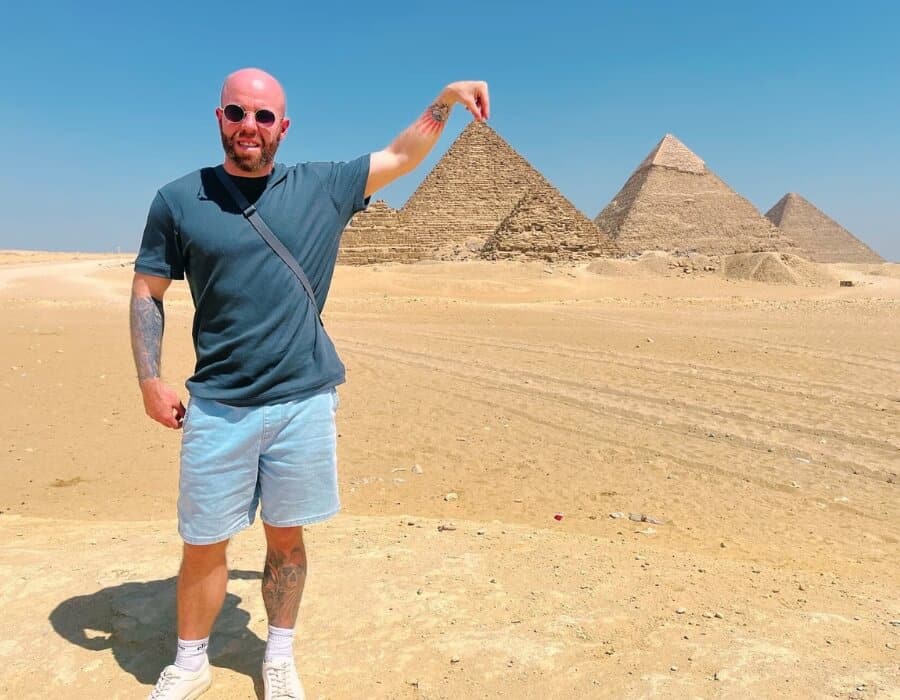
Understanding local etiquette in Giza goes a long way toward ensuring respectful interactions and a smooth travel experience. Egyptian culture places a high value on hospitality, tradition, and modesty — and as a visitor, showing cultural sensitivity will earn you appreciation and enhance your trip.
Key Cultural Etiquette Tips:
1. Dress Modestly
- While Giza is used to tourists, locals still appreciate conservative attire.
- Both men and women should cover shoulders and knees, especially in rural areas or when entering mosques or homes.
2. Greetings Matter
- A warm “Salam Alaikum” (peace be upon you) is the customary greeting.
- Handshakes are common, but wait for the other person to initiate — especially between men and women.
- Use your right hand for eating, handing items, or greeting — the left hand is considered impolite for these actions.
3. Tipping (Baksheesh) Is Expected
- Small tips (5–20 EGP) are standard for porters, restrooms, casual guides, and café service.
- While it may feel awkward at first, it’s an important part of the local economy and seen as a gesture of respect.
Here’s a detailed guide about Tipping in Egypt: A Complete Traveler’s Guide
4. Public Behavior
- Keep physical affection private — holding hands is generally fine, but hugging or kissing in public is frowned upon.
- Loud voices or strong criticism in public can be considered disrespectful.
5. Photography Etiquette
- Always ask before taking photos of people, especially women or in religious settings.
- Avoid pointing cameras at military or police installations, which is strictly prohibited.
Pro Insight: “Respect and curiosity go hand in hand in Egypt. A simple greeting or dressing modestly isn’t just polite — it opens doors to meaningful interactions and deeper local experiences.”
Packing Checklist for Giza
Whether you’re spending one day at the pyramids or exploring Giza over several days, packing smartly can greatly enhance your comfort, safety, and enjoyment. The desert climate, cultural norms, and terrain all require a carefully thought-out travel bag. Here’s your complete Giza packing checklist to ensure you’re prepared — without overpacking.
Don’t Miss to Read → What to Wear in Egypt: Ultimate Packing Guide
👕 Clothing Essentials
- Lightweight, breathable tops (preferably moisture-wicking)
- Long-sleeved shirt or shawl (for sun protection and modesty)
- Comfortable trousers or maxi skirts — avoid shorts in public spaces
- Light jacket or hoodie — desert mornings and evenings can be cool
- Scarf or shemagh — protects against sun, dust, and wind
- Sturdy walking shoes — for uneven terrain at archaeological sites
- Hat with a wide brim — crucial for sun protection
👜 Travel Accessories
- Daypack or anti-theft bag for daily outings
- Reusable water bottle (insulated is best)
- Sunglasses with UV protection
- Small first-aid kit (band-aids, painkillers, blister patches)
- Hand sanitizer and wet wipes
- Tissues or toilet paper (public restrooms may not provide these)
- Power bank for your phone — long touring days drain batteries fast
🧴 Health & Sun Protection
- Broad-spectrum sunscreen (SPF 30+)
- Insect repellent
- Lip balm with SPF
- Electrolyte tablets or rehydration salts
- Basic medications (anti-diarrheal, antihistamines, motion sickness tablets)
📄 Documents & Essentials
- Passport + photocopy
- Egypt entry visa
- Travel insurance printout
- Local currency (Egyptian Pounds) in small bills
- Hotel and tour confirmations (digital and/or printed)
Optional but Useful:
- Binoculars for desert stargazing tours
- Camera with zoom lens
- Notebook or journal
- Arabic phrasebook or translation app
- Flashlight or headlamp (handy in tombs and temples)
Pro Tip: Keep a separate zip pouch with all essential documents, emergency contacts, and backup cash in your daypack — and carry it with you at all times.
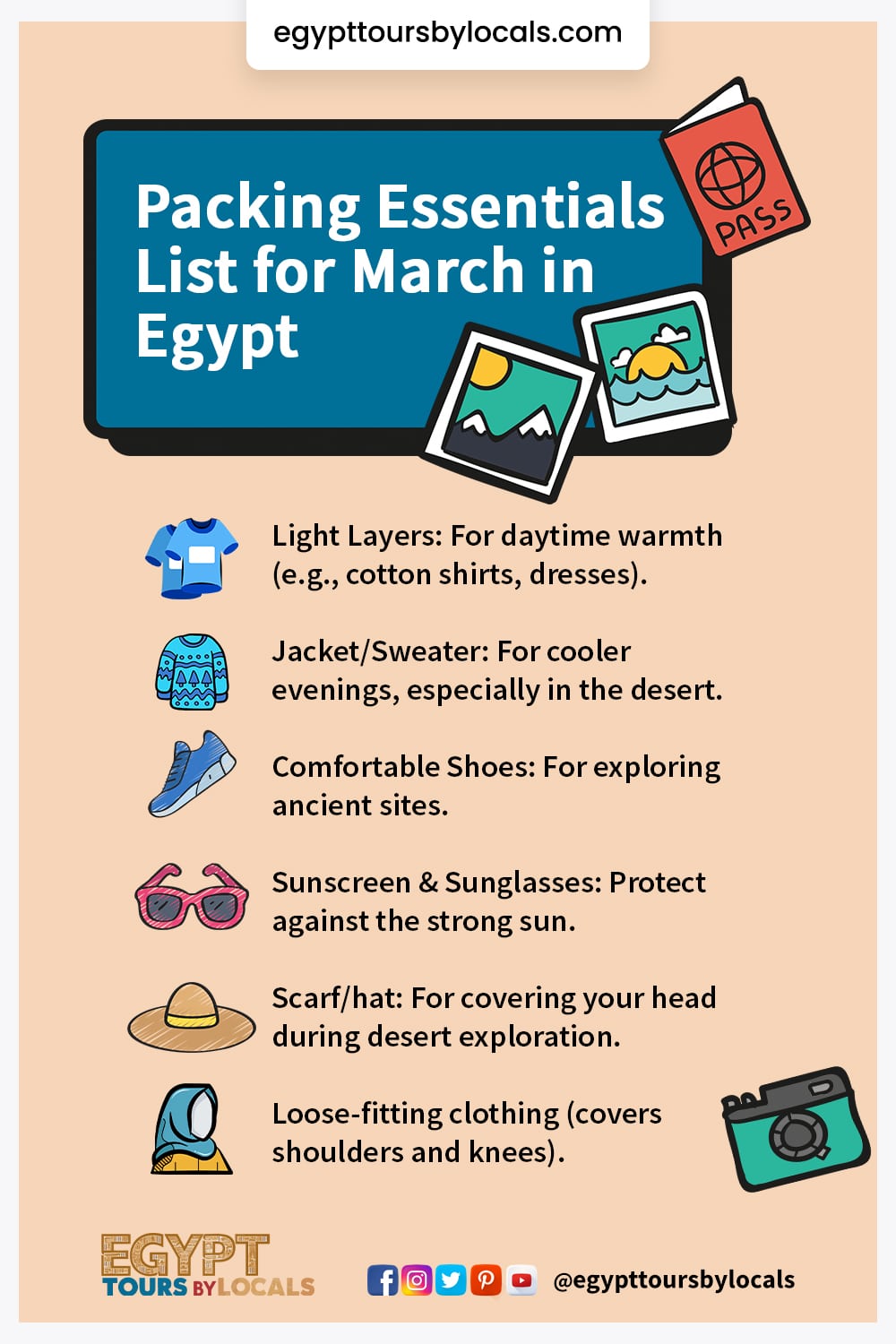
Where to Stay in Giza
Top Hotels with Pyramid Views
Waking up to a direct view of the Great Pyramids is one of the most surreal and memorable experiences you can have in Egypt. Whether you’re looking for luxury, mid-range comfort, or something more budget-friendly, Giza offers several hotels with unforgettable pyramid views — ideal for travelers who want history right outside their window.
Best Hotels with Iconic Pyramid Views:
🏨 Marriott Mena House
- Why it’s special: This historic 5-star hotel has hosted royalty and world leaders for over a century.
- Features: Lush gardens, fine dining, spa, and rooms with full-frontal views of the Pyramids.
- Pro tip: Book early — Pyramid View rooms sell out quickly, especially from October to April.
🏨 Egypt Pyramids Inn
- Why it’s special: A boutique-style guesthouse with panoramic rooftop views.
- Features: Friendly hosts, traditional breakfast, and an unbeatable sunset vantage point.
- Great for: Travelers who want a homey experience without sacrificing location.
🏨 Pyramids View Inn
- Why it’s special: Located right across from the Sphinx entrance, offering clear, close-up views of both the Sphinx and Pyramids.
- Features: Rooftop terrace, airport pickup, and direct walking access to the Giza Plateau.
🏨 Steigenberger Pyramids Cairo
- Why it’s special: A modern resort-style hotel offering a blend of comfort and luxury.
- Features: Two pools, multiple dining options, and pyramid-view balconies in select rooms.
Here’s a detailed guide about Where to Stay
What to Look for When Booking:
- Always confirm whether you’re booking a “Pyramid View” or “Garden View” — room types can vary.
- Check recent guest reviews for updates on renovations, noise levels, or view obstructions.
- Rooftop terraces can offer better photo opportunities than some room balconies.
Pro Insight: The Mena House’s garden sunrise view is unmatched — it’s the only place where you can sip your morning coffee with the pyramids glowing in golden light.
Best Budget-Friendly Accommodations
Traveling to Giza doesn’t require a luxury budget to enjoy an incredible experience. There are plenty of affordable and highly rated accommodations that offer comfort, convenience, and even pyramid views — all without breaking the bank. Whether you’re a backpacker, solo traveler, or family on a budget, these options deliver excellent value.
Top Budget Stays in Giza:
🏠 Guardian Guest House
- What makes it special: Located directly across from the Sphinx entrance, this guesthouse offers amazing rooftop views of the pyramids.
- Perks: Free Wi-Fi, local-style breakfast, and friendly staff who can help arrange tours.
- Bonus: Sunset views from the roof rival any luxury hotel.
🏠 Great Pyramid Inn
- What makes it special: Budget-friendly but full of charm, located just minutes from the plateau entrance.
- Perks: On-site restaurant, free airport pickup (check availability), and pyramid-facing balconies at a fraction of the cost of larger hotels.
🏠 Pyramids Eyes Hotel
- What makes it special: Located slightly off the main tourist strip, offering quieter surroundings and clean, spacious rooms at very reasonable rates.
- Perks: 24/7 front desk, modern design, and reliable air conditioning (a plus during hotter months).
🏠 Giza Pyramids View Inn
- What makes it special: Excellent option for solo travelers and couples wanting value + views.
- Perks: Rooftop lounge, helpful English-speaking hosts, and free daily breakfast.
Booking Tips:
- Look for deals on trusted platforms like Booking.com or Airbnb.
- Read recent reviews for insights into cleanliness, noise levels, and local support.
- Always verify whether taxes and service fees are included in the quoted price.
FAQs About Things to Do in Giza
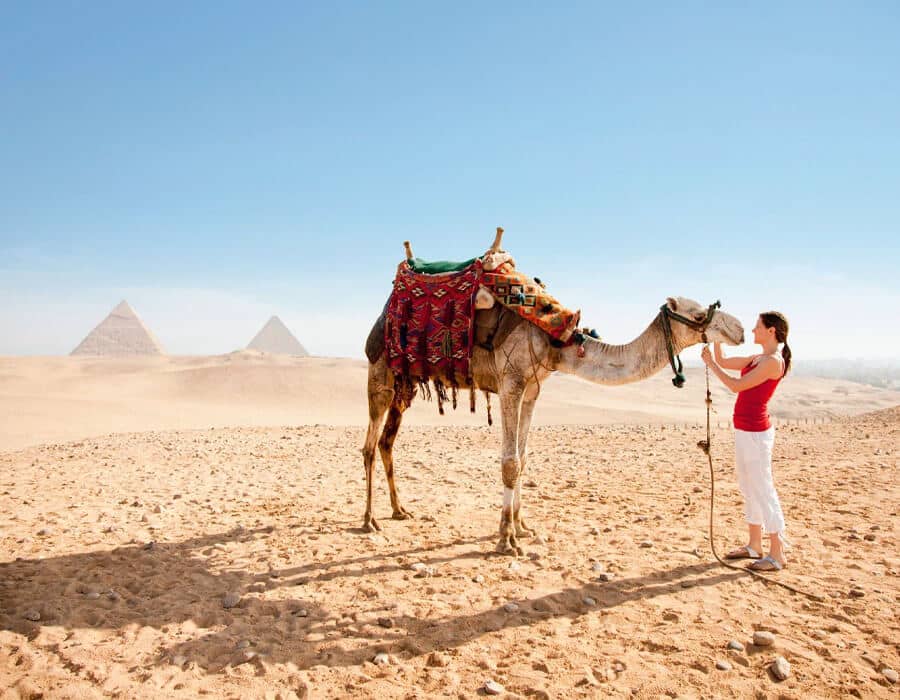
To help travelers get quick, practical answers, here are the most frequently asked questions about visiting Giza — from logistics to safety and unique experiences. These bite-sized insights can clear up common concerns and enhance planning.
1. What are the must-see attractions in Giza?
- The Great Pyramids, Sphinx, and Saqqara are essential.
- Don’t miss newer additions like the Grand Egyptian Museum (GEM) and camel rides at sunset.
2. Is Giza safe for tourists in 2025?
Yes, Giza remains generally safe for tourists. Stick with licensed guides, avoid unofficial vendors, and follow local etiquette. Travel during daylight and stay aware of your surroundings, especially in markets or crowded sites.
3. Can you go inside the pyramids?
Yes — but only select pyramids are open at a time, and entry requires a separate ticket. The Great Pyramid (Khufu) allows limited daily entries. Note: the interiors are narrow, hot, and not ideal for claustrophobic visitors.
4. How long do I need to explore Giza?
A full day covers the main pyramid complex and Sphinx. Add 1–2 more days if you want to visit Saqqara, the Grand Egyptian Museum, or enjoy camel rides and stargazing.
5. What should I wear when visiting Giza?
Opt for modest, breathable clothing. Light layers, closed shoes, and sun protection (hat, sunglasses, SPF) are musts. If visiting religious sites or rural areas, ensure shoulders and knees are covered.
6. How much does it cost to visit the pyramids?
Basic entry to the Giza Plateau (as of 2025) is around 240 EGP (~$8 USD). Additional tickets are required for entering the Great Pyramid or museums. Guided tours vary from $25–$100+ depending on customization.
7. Are there restaurants or cafes near the pyramids?
Yes — several cafes and rooftop restaurants near the entrance offer meals with pyramid views. For an elevated experience, try Mena House Hotel’s garden restaurant or local eateries like Felfela Giza.
Final Thoughts
Giza is more than a bucket-list destination — it’s a living bridge between ancient wonders and vibrant local culture. From the awe-inspiring Great Pyramids and Sphinx to camel rides at sunset, hidden treasures in Saqqara, and the promise of modern marvels like the Grand Egyptian Museum, every moment in Giza offers a story worth telling.
Whether you’re a history buff, first-time traveler, or cultural explorer, this iconic region has something to offer you — if you take the time to go beyond the surface. Walk slowly. Talk to locals. Watch the desert sky. Let the weight of 4,500 years of human history sink in.
Plan ahead, stay curious, and be open to discovery — Giza will reward you with unforgettable experiences that last far beyond your return flight.
